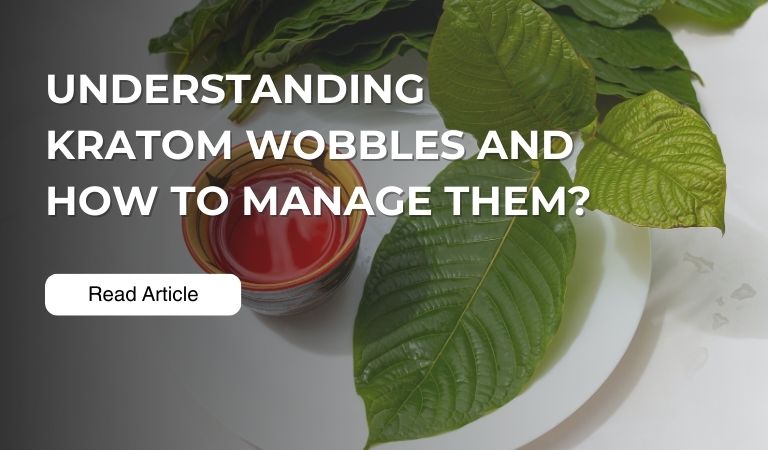Imagine stepping into the lush world of Southeast Asia, where a natural wonder grows. Kratom is a natural plant that has gained popularity in various parts of the world for its potential therapeutic effects. People from around the world have been curious about it because they believe it might bring them relief or make them feel improved. But just like anything else, there’s a twist to the tale – something called ‘kratom wobbles.’ It’s like feeling a bit shaky or dizzy, and it can happen when you use kratom.
In this article, we’re going to unravel the mystery of kratom wobbles. In this article, we’ll talk about what kratom wobbles are, why they happen, and how to stop them from messing up your experience.
What are Kratom Wobbles?
You must have stumbled upon the intriguing term kratom wobbles in online discussions involving kratom. Kratom wobbles, also known as “the wobbles” or “kratom eye wobbles,” refer to an undesirable side effect experienced by the use of kratom.
Kratom wobbles are an unwelcome companion for some kratom enthusiasts. They manifest as an unsettling side effect that can leave users feeling uncomfortable and off-balance. But what exactly are these wobbles?
It is characterized by uncontrollable eye movement, resulting in distorted vision and impaired depth perception. This sensation is often accompanied by feelings of dizziness and a spinning sensation, similar to the effects of mild intoxication. Users may also experience dizziness, nausea, and a general sense of discomfort.
Furthermore, individuals experiencing kratom wobbles may notice instability in their body, particularly in their legs. This makes walking a challenging task. These side effects are linked to a condition called nystagmus, which can be triggered by central nervous system disorders, as well as the consumption of alcohol and opioids. It’s an uncomfortable sensation, and many users have reported to experience these symptoms.
Note: Many individuals find that the wobbles are more likely to occur when consuming brewed kratom tea with strains, which has led to the belief that it may be an effect triggered by one of the fat-soluble alkaloids.
Causes of Kratom Wobbles
The exact cause of kratom wobbles is not fully understood, but there are several factors that may contribute to this uncomfortable sensation:
- Dosage: Taking an excessively high dose of kratom, especially for beginners or individuals with low tolerance, increases the likelihood of experiencing wobbles.
- Strain Variability: Certain kratom strains may be more prone to causing wobbles due to their alkaloid composition. Maeng Da and Bali strains, for example, are often associated with this side effect.
- Potency: The potency of the kratom product can vary, and stronger strains are more likely to induce wobbles.
- Individual Sensitivity: People have different sensitivities to kratom, and what causes wobbles in one person may not affect another.
- Dehydration: Kratom can have a dehydrating effect, and not drinking enough water can exacerbate wobbles.
Preventing and Managing Kratom Wobbles
Fortunately, there are steps you can take to prevent and manage kratom wobbles. Here is a guideline for you to consider while taking kratom.
- Proper Dosage: If you’re new to kratom or trying a potent strain, begin with a small dose. Gradually increase the amount of powder as needed. Using a kitchen scale is the most accurate way to measure your dosage, ensuring that you stay within safe limits. Avoid taking excessively high doses.
- Choose Wisely: Experiment with different kratom strains to find one that suits your needs without causing wobbles. Less potent strains may be a better option for some users. Strains with higher concentrations of 7-hydroxymitragynine are more likely to induce wobbles. In general, a modest kratom dose ranges from 2 to 5 grams and is ideal for enhancing energy and mood. Larger doses, spanning from 6 to 12 grams, are better suited for addressing sleep-related issues and managing pain.
- Stay Hydrated: Drink plenty of water when using kratom to counteract its potential dehydrating effects. This can help reduce the severity of wobbles.
- Take Breaks: Avoid using kratom every day to prevent building up tolerance, which can lead to higher doses and an increased risk of wobbles.
- Manage Your Environment: Sit or lie down in a comfortable and stable environment if wobbles occur. This can help reduce dizziness and discomfort.
- Natural Remedies: Some users have reported that consuming ginger or other natural remedies can alleviate the symptoms of wobbles.
- Consult a Healthcare Professional: If you experience severe or persistent wobbles, it’s advisable to seek medical advice.
Kratom Strains Associated with Wobbles
You might have heard that certain kratom strains are more likely to induce wobbles due to varying alkaloid concentrations. This diversity in alkaloid composition is one of the factors behind the occurrence of what users commonly refer to as ‘the wobbles.’
In general, strains with higher sedative effects are associated with an increased risk of wobbles. Some red vein varieties tend to be associated with an increased risk of experiencing the wobbles.
Below are several strains that have the potential to induce the wobbles:
- Red Malay: It is known for its balanced and long-lasting effects.
- Red Borneo: This strain offers a smooth and relaxing experience.
- Red Bali: It is praised for its potent pain relief.
- Red Indo: It is valued for its mellow and calming properties.
This is because sedating strains often have a higher concentration of the calming alkaloid, 7-hydroxymitragynine, which can contribute to feelings of dizziness and unsteadiness when consumed in excess.
Users seeking to avoid the wobbles may want to exercise caution when using these sedating strains and, as previously mentioned, consider starting with lower doses. Balancing the stimulating and sedating effects of different strains can also be a useful approach to minimize the risk of discomfort and side effects while benefiting from the unique qualities of each strain. As always, individual reactions can vary, so it’s essential to pay close attention to how your body responds and adjust your kratom usage accordingly. You should use these strains sparingly.
Other Side Effects of Kratom
Aside from wobbles, kratom can produce various other side effects, particularly when consumed in excessive amounts. These side effects may include anxiety, constipation, headaches, and nausea. Kratom also has the potential for addiction, although it is generally considered less severe than opioid addiction. Overdosing on kratom is rare and typically involves the use of other substances.
What are the remedies to get rid of kratom Wobbles?
Although there is limited information available on addressing the wobbles, a few strategies may aid in alleviating this discomfort.
- Activated Charcoal: This supplement stands out as one of the most efficient methods to alleviate the wobbles. It operates by adsorbing a portion of the alkaloids responsible for causing the wobbles, significantly reducing their impact.
- Food/Carbonated Drinks: While they may not directly eliminate the wobbles, these options can expedite the digestive process, potentially helping the symptoms dissipate more rapidly, if they do occur.
Conclusion:
In conclusion, kratom wobbles are an uncomfortable but manageable side effect that some users may experience. By being mindful of your dosage, strain selection, and hydration, you can minimize the risk of wobbles and enjoy the potential benefits of kratom more comfortably. Always remember that individual responses to kratom vary, so it’s essential to find the right approach that works for you while using this natural herb responsibly.


